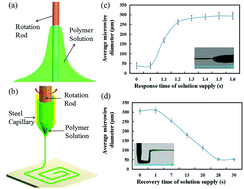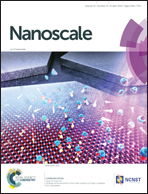The microscale Weissenberg effect for high-viscosity solution pumping at the picoliter level†
Abstract
Transportation of highly viscous solutions at the picoliter level with a rapid dynamic response is paramount for micro/nano-fabrication. With the advantages of a higher length-wall (thickness) ratio and a more stable free surface compared to those of the traditional Weissenberg effect (TWE), the microscale Weissenberg effect (MWE) can continuously and controllably pump high-viscosity solutions at the picoliter scale. Some typical characteristics and behaviors of MWE are investigated as the rotation rod diameter decreases to the microscale of ∼100 μm. The pumped minimum solution volume can reach 167.5 pL per second, and the minimum response time of solution pumping is 0.3 s, which is much shorter than that of pressure driven pumping. Then, a new direct writing with an adjustable jet diameter based on the MWE is proposed to write microstructures on a substrate from a solution with a viscosity of approximately 130.1 Pa s. The stability of the as-spun jet and the deposited structures is improved when a high voltage is applied. To fully demonstrate the advantages of MWE, MWE-based direct writing is performed to successfully fabricate microfluidic channels with variable diameters. Thus, the system can overcome the problems of high transport resistance to the pumping of a high-viscosity solution.



 Please wait while we load your content...
Please wait while we load your content...